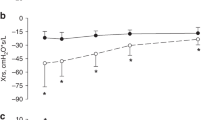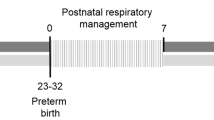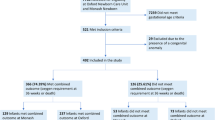Abstract
Summary: Comparison between 21 2-day-old infant monkeys and 17 21-day-old infants during non-rapid eye movement sleep demonstrated that minute ventilation (V1) increased from 141 ± 30 to 257 ± 65 ml/min secondary to elevations in tidal volume (VT) and mean inspiratory flow (VT/Ti) with little change in respiratory timing. These volumetric parameters of ventilation as well as functional residual capacity remained significantly augmented when standardized for gain in body weight. Dynamic lung compliance increased from 0.69 ± 0.19 to 0.89 ± 0.39 ml/cm H2O with age while inspiratory pulmonary resistance did not change. Effective elastance fell significantly with maturation (5.27 ± 1.51 cm H2O/ml on day 2 versus 4.15 ± 1.35 cm H2O/ml on day 21) while effective impedance was elevated postnatally. The postnatal ventilatory gain (80% increase in V1) was attributable to increases both in dynamic lung compliance (30%) and inspiratory effort (50%) as determined by esophageal pressure changes. Isometric occlusion pressures (P0.1, P0.2 … Pmax) also significantly increased during this time span, suggesting that the increased ventilation resulted from an elevated respiratory drive.
Similar content being viewed by others
Log in or create a free account to read this content
Gain free access to this article, as well as selected content from this journal and more on nature.com
or
Author information
Authors and Affiliations
Rights and permissions
About this article
Cite this article
LaFramboise, W., Tuck, R., Woodrum, D. et al. Maturation of Eupneic Respiration in the Neonatal Monkey. Pediatr Res 18, 943–948 (1984). https://doi.org/10.1203/00006450-198410000-00007
Received:
Accepted:
Issue date:
DOI: https://doi.org/10.1203/00006450-198410000-00007



